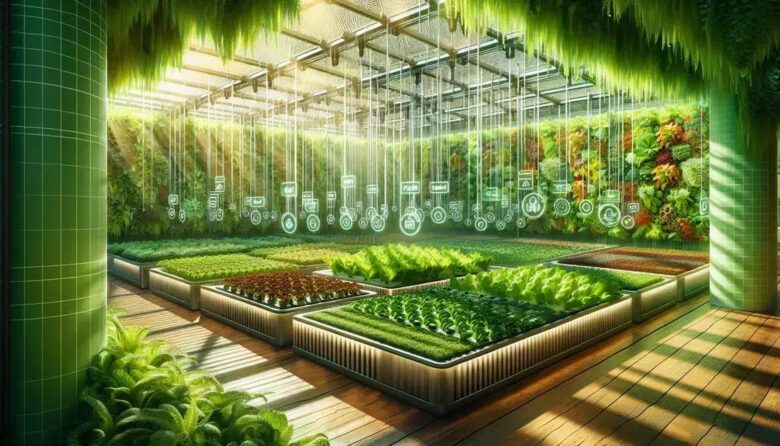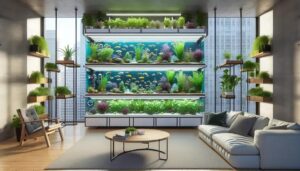Ever wondered how to keep your hydroponic plants thriving? Using hydroponic sensors to monitor water quality might just be the answer. These devices provide crucial insights, ensuring everything runs smoothly and helping you make informed decisions for your green oasis. Let’s explore how they work and why they’re a game-changer.
how hydroponic sensors work
Hydroponic sensors work by continuously monitoring the critical parameters of your plant’s environment, such as pH levels, nutrient concentration, and water temperature. These sensors use digital technology to provide real-time data that allows growers to immediately respond to changes.
Most hydroponic sensors are connected to a central network, enabling you to access data remotely via apps or computer software. This connectivity makes it easier to manage large systems without being physically present. Advanced sensors even offer predictive analytics, giving you insights into future conditions based on current data trends.
Understanding how these sensors function is essential. They use probes that extend into the water solution to extract readings, which are then converted into digital signals for analysis. Maintenance is minimal but crucial, mostly involving cleaning the probes and recalibrating the sensors periodically to ensure accuracy.
key benefits of monitoring water quality
Monitoring water quality in hydroponics is crucial for ensuring healthy plant growth. Regular checks help maintain balanced pH levels and nutrient concentrations, preventing plant stress and promoting optimal absorption of nutrients.
By closely observing water conditions, growers can reduce the risk of diseases that thrive in poor water conditions, ensuring that plants remain robust and productive. This proactive approach allows for early intervention, minimizing potential losses and maximizing yields.
Additionally, understanding water quality helps in resource management. When the nutrient solution is at its best, less water and fewer nutrients are wasted, making the entire operation more sustainable and eco-friendly.
Efficient water quality monitoring can also improve crop consistency and flavor, making your produce more appealing to consumers and potentially increasing overall market value.
choosing the right sensors for your system
Selecting the right sensors for your hydroponic system is crucial for effective management and healthy plant growth. Start by assessing the specific needs of your crops, as different plants may require monitoring of various parameters such as pH, electrical conductivity, or temperature.
Consider sensor compatibility with your existing setup. Some sensors connect easily to digital systems, providing real-time updates directly to your smartphone or computer. This feature allows for seamless integration and efficient monitoring.
Look at the durability and accuracy of the sensors. High-quality sensors might come at a higher price, but they offer greater longevity and precise measurements that can save costs in the long run by preventing nutrient wastage or plant damage.
Factor in the ease of use and maintenance. Opt for sensors that are easy to install and require minimal upkeep. Some models offer self-calibration features, reducing the time and effort needed for maintenance.
installation tips for hydroponic sensors
Proper installation of hydroponic sensors is key to ensuring accurate and reliable data collection. Start by positioning the sensors in areas that represent the overall conditions of the system. Avoid placing sensors too close to air stones or water pumps, as this can create inconsistent readings due to turbulence.
Secure the sensors properly to prevent them from shifting or becoming dislodged. Some sensors come with clips or mounts specifically designed to hold them in place. Follow the manufacturer’s guidelines for optimal placement and depth in the nutrient solution.
Ensure that all electrical connections are sealed and protected from moisture to prevent short circuits and sensor damage. Use waterproof connectors or sealant tape around connection points. If your sensors connect to a network, ensure you have stable connectivity to receive data smoothly.
Double-check the sensor’s calibration before use. Many sensors come pre-calibrated, but it’s a good practice to verify their accuracy against a known standard. This step can help prevent erroneous data that could impact plant health.
maintenance practices for optimal performance
Regular maintenance is essential for ensuring the optimal performance of hydroponic sensors. Start by cleaning the sensor probes to prevent the build-up of algae or mineral deposits, which can affect accuracy. Use a soft brush or cloth and follow the manufacturer’s instructions for each cleaning session.
Calibration is crucial for maintaining precise readings. Check and calibrate sensors regularly using calibration solutions recommended for your specific sensor type. This process ensures that the sensors provide accurate data over time, crucial for maintaining your hydroponic system’s balance.
Inspect all connections for signs of wear or corrosion. Secure any loose wires and replace damaged cables to avoid connectivity issues. This prevents data loss and ensures sensors communicate effectively with your monitoring devices.
Perform a routine check on the software that supports your sensors. Keep the software updated to benefit from the latest features and fixes. Regular updates may improve system efficiency and functionality, keeping your system running smoothly.
troubleshooting common sensor issues
Troubleshooting common issues with hydroponic sensors helps maintain their efficacy and your system’s productivity. Start by checking power sources and connections if a sensor stops transmitting data. Loose or corroded wires might cause interruptions, so ensure all connections are secure and free from moisture.
If you receive erroneous readings, consider recalibrating the sensor. Sensors may drift over time, requiring periodic calibration to ensure accuracy. Utilize calibration solutions appropriate for your sensor type and follow the manufacturer’s guidelines for best results.
Debris and mineral build-up on probes can lead to faulty readings. Regularly clean all sensor surfaces with a soft cloth and appropriate cleaning solutions to maintain proper functionality.
Software updates might resolve persistent issues. Check for firmware updates from the manufacturer to benefit from improved sensor performance and new features. Keeping the software and firmware current can often alleviate unexplained problems.
Wrapping Up Hydroponic Sensor Insights
Implementing hydroponic sensors can revolutionize your growing system by offering precise control over plant environments. These sensors empower you with real-time data, optimizing water quality and improving yields. Choosing the right sensors and installing them correctly are essential steps in this process.
Consistent maintenance ensures sensors perform at their best, while troubleshooting common issues can prevent potential disruptions. Staying proactive in sensor management leads to healthier plants and more efficient resource use.
Adopting these practices not only enhances your green thumb expertise but also keeps your hydroponic setup thriving. Don’t underestimate the impact that well-managed monitoring technology can have on your successful gardening endeavors.
FAQ – Frequently Asked Questions about Hydroponic Sensors and Water Quality
How do hydroponic sensors improve plant growth?
Hydroponic sensors provide real-time data on water quality, helping maintain optimal nutrient levels and pH balance, essential for healthy plant growth.
What parameters do hydroponic sensors typically monitor?
These sensors commonly monitor parameters like pH, electrical conductivity (EC), temperature, and nutrient concentration.
How often should I calibrate my hydroponic sensors?
Calibration frequency depends on usage and sensor type, but generally, sensors should be calibrated every few months for accuracy.
Can I integrate hydroponic sensors with my smartphone?
Yes, many modern sensors offer connectivity features that allow real-time data access and management via smartphone apps.
What are the common issues faced with hydroponic sensors?
Common issues include inaccurate readings due to dirty probes, poor calibration, or faulty connections.
Are there any maintenance tools recommended for hydroponic sensors?
Basic maintenance tools include soft brushes for cleaning, calibration solutions for accuracy, and protective covers for connectivity points.



